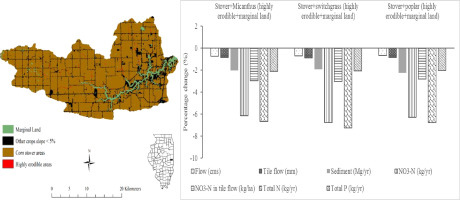当前位置:
X-MOL 学术
›
Sci. Total Environ.
›
论文详情
Our official English website, www.x-mol.net, welcomes your
feedback! (Note: you will need to create a separate account there.)
Evaluation of bioenergy crop growth and the impacts of bioenergy crops on streamflow, tile drain flow and nutrient losses in an extensively tile-drained watershed using SWAT
Science of the Total Environment ( IF 8.2 ) Pub Date : 2017-09-20 , DOI: 10.1016/j.scitotenv.2017.09.148 Tian Guo , Raj Cibin , Indrajeet Chaubey , Margaret Gitau , Jeffrey G. Arnold , Raghavan Srinivasan , James R. Kiniry , Bernard A. Engel
Science of the Total Environment ( IF 8.2 ) Pub Date : 2017-09-20 , DOI: 10.1016/j.scitotenv.2017.09.148 Tian Guo , Raj Cibin , Indrajeet Chaubey , Margaret Gitau , Jeffrey G. Arnold , Raghavan Srinivasan , James R. Kiniry , Bernard A. Engel

|
Large quantities of biofuel production are expected from bioenergy crops at a national scale to meet US biofuel goals. It is important to study biomass production of bioenergy crops and the impacts of these crops on water quantity and quality to identify environment-friendly and productive biofeedstock systems. SWAT2012 with a new tile drainage routine and improved perennial grass and tree growth simulation was used to model long-term annual biomass yields, streamflow, tile flow, sediment load, and nutrient losses under various bioenergy scenarios in an extensively agricultural watershed in the Midwestern US. Simulated results from bioenergy crop scenarios were compared with those from the baseline. The results showed that simulated annual crop yields were similar to observed county level values for corn and soybeans, and were reasonable for Miscanthus, switchgrass and hybrid poplar. Removal of 38% of corn stover (3.74 Mg/ha/yr) with Miscanthus production on highly erodible areas and marginal land (17.49 Mg/ha/yr) provided the highest biofeedstock production (279,000 Mg/yr). Streamflow, tile flow, erosion and nutrient losses were reduced under bioenergy crop scenarios of bioenergy crops on highly erodible areas and marginal land. Corn stover removal did not result in significant water quality changes. The increase in sediment and nutrient losses under corn stover removal could be offset with the combination of other bioenergy crops. Potential areas for bioenergy crop production when meeting the criteria above were small (10.88 km2), thus the ability to produce biomass and improve water quality was not substantial. The study showed that corn stover removal with bioenergy crops both on highly erodible areas and marginal land could provide more biofuel production relative to the baseline, and was beneficial to water quality at the watershed scale, providing guidance for further research on evaluation of bioenergy crop scenarios in a typical extensively tile-drained watershed in the Midwestern U.S.
中文翻译:

使用SWAT评估广泛排水的流域中生物能源作物的生长以及生物能源作物对水流,瓷砖排水流和养分流失的影响
预期在全国范围内从生物能源作物中大量生产生物燃料,以满足美国的生物燃料目标。重要的是研究生物能源作物的生物量生产以及这些作物对水量和水质的影响,从而确定对环境友好的生产性生物原料系统。在美国中西部一个广泛的农业流域中,采用新的瓷砖排水程序和改进的多年生草木生长模拟的SWAT2012可以对各种生物能源情景下长期年生物量的长期年产量,水流,瓷砖流量,沉积物负荷和养分流失进行建模。 。将来自生物能源作物情景的模拟结果与来自基线的模拟结果进行了比较。结果表明,模拟的年度作物产量与观察到的县级玉米和大豆水平值相似,并且对于芒草,柳枝and和杂种杨。在易侵蚀的地区和边际土地上的芒草产量减少了38%的玉米秸秆(3.74 Mg / ha / yr),提供了最高的生物原料产量(279,000 Mg / yr)。在高侵蚀性地区和边际土地上,在生物能源作物的生物能源作物情景下,溪流,瓷砖流量,侵蚀和养分损失减少了。去除玉米秸秆并没有导致水质的显着变化。去除玉米秸秆后沉积物和养分流失的增加可能被其他生物能源作物的组合所抵消。满足上述条件的生物能源作物生产的潜在面积很小(10.88 km 2),因此生产生物质和改善水质的能力并不重要。研究表明,相对于基准线,在高侵蚀性地区和边际土地上用生物能源作物去除玉米秸秆可以提供更多的生物燃料产量,并且对分水岭规模的水质有利,为进一步评估生物能源作物情景提供了指导在美国中西部一个典型的大面积排水的分水岭中
更新日期:2017-09-21
中文翻译:

使用SWAT评估广泛排水的流域中生物能源作物的生长以及生物能源作物对水流,瓷砖排水流和养分流失的影响
预期在全国范围内从生物能源作物中大量生产生物燃料,以满足美国的生物燃料目标。重要的是研究生物能源作物的生物量生产以及这些作物对水量和水质的影响,从而确定对环境友好的生产性生物原料系统。在美国中西部一个广泛的农业流域中,采用新的瓷砖排水程序和改进的多年生草木生长模拟的SWAT2012可以对各种生物能源情景下长期年生物量的长期年产量,水流,瓷砖流量,沉积物负荷和养分流失进行建模。 。将来自生物能源作物情景的模拟结果与来自基线的模拟结果进行了比较。结果表明,模拟的年度作物产量与观察到的县级玉米和大豆水平值相似,并且对于芒草,柳枝and和杂种杨。在易侵蚀的地区和边际土地上的芒草产量减少了38%的玉米秸秆(3.74 Mg / ha / yr),提供了最高的生物原料产量(279,000 Mg / yr)。在高侵蚀性地区和边际土地上,在生物能源作物的生物能源作物情景下,溪流,瓷砖流量,侵蚀和养分损失减少了。去除玉米秸秆并没有导致水质的显着变化。去除玉米秸秆后沉积物和养分流失的增加可能被其他生物能源作物的组合所抵消。满足上述条件的生物能源作物生产的潜在面积很小(10.88 km 2),因此生产生物质和改善水质的能力并不重要。研究表明,相对于基准线,在高侵蚀性地区和边际土地上用生物能源作物去除玉米秸秆可以提供更多的生物燃料产量,并且对分水岭规模的水质有利,为进一步评估生物能源作物情景提供了指导在美国中西部一个典型的大面积排水的分水岭中











































 京公网安备 11010802027423号
京公网安备 11010802027423号